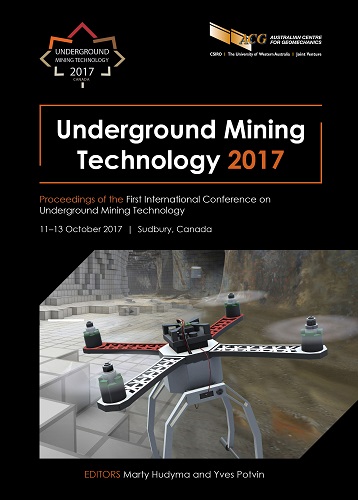Estimation of fill strength requirements using bonded particle modelling for mining under cemented rockfill

|
Authors: Turichshev, A; Cotesta, L; Brummer, R; Beauvais, M |
DOI https://doi.org/10.36487/ACG_rep/1710_30_Turichshev
Cite As:
Turichshev, A, Cotesta, L, Brummer, R & Beauvais, M 2017, 'Estimation of fill strength requirements using bonded particle modelling for mining under cemented rockfill', in M Hudyma & Y Potvin (eds), UMT 2017: Proceedings of the First International Conference on Underground Mining Technology, Australian Centre for Geomechanics, Perth, pp. 387-398, https://doi.org/10.36487/ACG_rep/1710_30_Turichshev
Abstract:
Recovery of sill pillars is often associated with mining under existing backfill. The backfill stability in such cases is of primary concern due to risks associated with personnel safety, equipment loss, and ore dilution. Two key aspects that control the stability of exposed backfill are the fill strength and the size of the fill exposure. Use of stronger fill will allow for increased excavation size but will come at a higher cost because of higher binder content requirements. A mine operator, therefore, must decide what combination of excavation size and fill strength is appropriate. In this paper we present the results of a study for a base metal mine in Canada aimed at estimating the strength requirements for cemented rockfill (CRF) being undercut. Numerical simulations utilising bonded particle models were used to relate the size of the undercut to the CRF strength requirements. The results were expressed as the depth of fill failure and as ore dilution, allowing the operator to select appropriate fill strength.
Keywords: cemented rockfill, bonded particle modelling, particle flow code (PFC), numerical simulations
References:
Annor, AB 1999, ‘A study of characteristics and behaviour of composite backfill material’, PhD thesis, McGill University, Montreal.
Brummer, RK, Andrieux, PP & O’Connor CP 2003, ‘Stability analyses of undermined sill mats for base metal mining’, in RK Brummer, PP Andrieux, C Detournay & R Hart (eds), Proceedings of the 3rd International FLAC Symposium, A.A. Balkema, Rotterdam.
Itasca Consulting Group, Inc. 2014, Particle Flow Code in 3D, version 5.0 software documentation, Itasca Consulting Group, Inc., Minneapolis.
Itasca Consulting Group, Inc. 2017, Particle Flow Code, Itasca Consulting Group, Inc., Minneapolis, viewed 21 July 2017,
Lafarge 2012, Results of laboratory UCS tests on CRF samples, internal report, unpublished.
Mitchell, RJ 1991, ‘Sill mat evaluation using centrifuge models’, Mining Science and Technology, vol. 13, no. 3, pp. 301–313.
Pakalnis, RT, Caceres, C, Clapp, K, Morin, M, Brady, T, Williams, T, Blake, W & MacLaughlin, M 2005, ‘Design spans – underhand cut and fill mining’, Proceedings of the 107th CIM-AGM, Canadian Institute of Mining, Metallurgy and Petroleum, Westmount.
Pakalnis, RT & Hughes, PB 2011, ‘Sublevel stoping’, in P Darling (ed.), SME Mining Engineering Handbook, 3rd edn, Society for Mining, Metallurgy, and Exploration, Englewood.
Pierce, M, Potyondy, D, Andrieux, PP & Lessard, J-S 2002, ‘Use of the Particle Flow Code (PFC2D) to assess stability of undercut rockfill at Brunswick mine’, in R Hammah, W Bawden, J Curran & M Telesnicki (eds), Proceedings of the 5th North American Rock Mechanics Symposium and the 17th Tunnelling Association of Canada Conference, vol. 1, University of Toronto Press, Toronto, pp. 173–180.
Potyondy, DO & Cundall, PA 2004, ‘A bonded-particle model for rock’, International Journal of Rock Mechanics and Mining Sciences, vol. 41, no. 8, pp. 1329–1364.
© Copyright 2025, Australian Centre for Geomechanics (ACG), The University of Western Australia. All rights reserved.
View copyright/legal information
Please direct any queries or error reports to repository-acg@uwa.edu.au
View copyright/legal information
Please direct any queries or error reports to repository-acg@uwa.edu.au